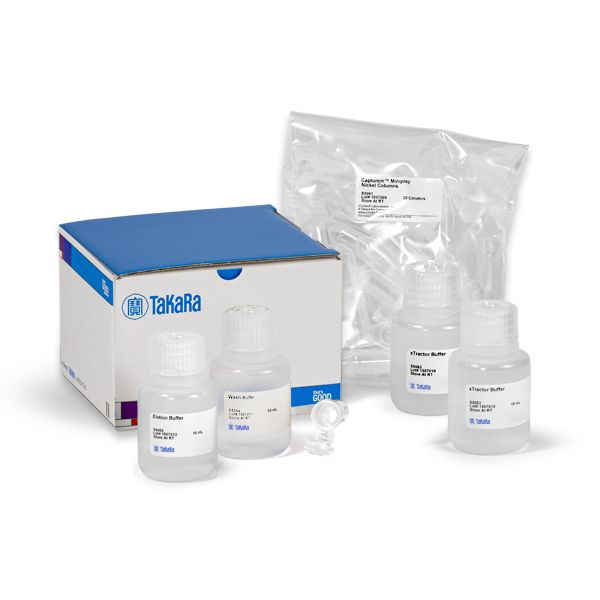Capturem His-Tagged Purification Miniprep Kit
Capturem His-Tagged Purification Miniprep Kit
Capturem high-capacity membranes
The Capturem His-Tagged Purification Miniprep Kit provides single-use disposable membrane spin columns for simple, rapid purification of his-tagged proteins in up to 800 μl of clarified lysate. The columns are suitable for use under native or denaturing conditions, in the presence of additives such as DTT (up to 10 mM), βME (up to 30 mM), TCEP (up to 5 mM), EDTA (up to 10 mM), or glycerol.
Overview
- No-waiting workflow—5-minute, room-temperature protocol
- High purity and yield—small column bed volumes trap fewer contaminants and allow large-volume washes
- Compatible with wide range of conditions—native and denaturing conditions; with common additives (e.g., EDTA, DTT, BME, glycerol, TCEP, etc.; see compatibility table)
- Lysis buffer compatibility—xTractor Buffer; buffers from other vendors
- Different cell systems—easy purification from mammalian and bacterial cells
Applications
- Biochemical/enzymatic assays
- Pull-down or other protein interaction assays
- Confirmation screening
- Protein/ligand affinity analysis
- Crystallography or other structural analyses
- Antibody production
- Toxicology studies
- Protein transfer to live cells
Protein purification miniprep workflow

Purification of GFPuv in the presence of a wide range of additives, at varying concentrations

Purification of GFPuv under native and denaturing conditions

Purification of 6xhis-tagged proteins expressed in mammalian cells

Capturem Protein A- or G-functionalized membranes

Antibody purification workflow for Capturem Protein A or G 96-well plates. Each well can be loaded with up to 850 µl of a diluted sample (antibody sample diluted from 1:1 to 1:20 with buffer). Following binding, the membrane is then washed and the bound antibiody eluted with the appropriate buffers. Note: Protocol time varies for each format. Check user manuals for specifics on protocol times.
Capturem spin columns and filtration devices

Available Capturem spin column and filtration device formats. Pictured from left to right: nanoprep, miniprep, 96-well, 24-well, maxiprep, and large-volume Capturem formats. Formats available vary for the different functionalized membranes. Check product pages for list of available formats.
Load volumes and approximate yields for available Capturem formats by chemistry

Load volumes and yields of Capturem purification formats.


